It had to be done. You simply don’t come to India without visiting the Taj Mahal. So on the second morning of our tour, after the night I lost my cell phone, we saddled up early and caught the train from Delhi to Agra.
The Indian railways system is the biggest in the world. 14 zillion people ride it every day, there are enough miles of track to reach from Mumbai to Pluto and it employs 86.2% of the population (the rest are employed selling Taj Mahal snow globe key chains and chai). Ok, I made most of that up, except it’s true that the system is the biggest in the world, and riding it turns out to be a really good way of seeing India – not just the landscape but the people and the culture. One of the things I’m enjoying about being back on an Intrepid tour after my two weeks as an Imaginative Traveller in the Middle East is that with Intrepid we take a lot more local transport. If this was my ImTrav tour we probably would’ve got a private minibus downtown to Old Delhi, and driven from Delhi to Agra. Nevermind that if we’d had a private bus in Delhi I’d probably still have my cell phone – traveling should be about experiencing the places you visit, not viewing them from behind glass.
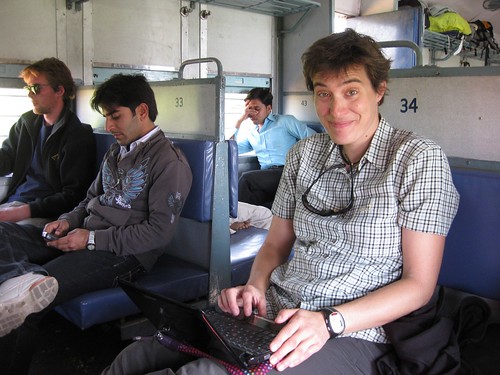 The Indian Railway System is also a good place to write a blog. (Jono and Akshay pictured at the left!)
The Indian Railway System is also a good place to write a blog. (Jono and Akshay pictured at the left!)Pulling out of the station in Delhi at 7:00 in the morning was an eye-opener. It turns out that the train tracks aren’t just for carrying trains. They’re also a gigantic garbage heap and a place to dry laundry, and a toilet. I couldn’t count how many people we saw who simply dropped their pants to squat down on the tracks. It’s hard not to be shocked and saddened and disgusted, which are all the things that everyone says you’ll feel about India. I’m glad that I scheduled this stop as I did – I think that going through Africa and the Middle East first has made it a bit easier for me to accept the conditions here, which are definitely worse. Patti has traveled a lot in China and Southeast Asia, and she says things are far worse here than anything she’s seen in those places.
Back on the train, we made it to Agra by about 11:00am and quickly headed out to see the Agra Fort. It was interesting, and we had a nice local guide, but ultimately it felt like a bit of a time-killer because we weren’t scheduled to go see the Taj Mahal until just before sunset, so we could get the all-important “money shot” of the Taj. The fort is still 75% controlled by the Indian Army, but the 25% that’s open to the public was quite nice. It was a former palace to a long line of Indian rulers, including the one who built the Taj Mahal, Shah Jahan. There are private apartments and public meeting areas and a lot of very nice carved stone and marble inlaid with semiprecious gems.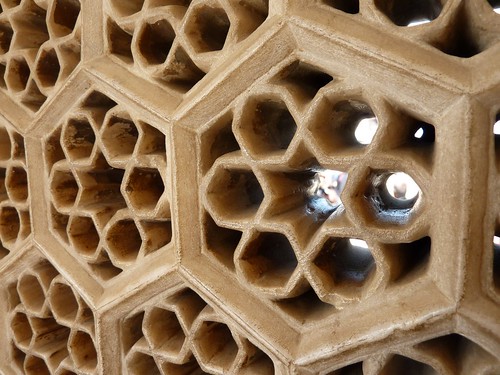 A bit of intricately carved stone screen – it was about three inches thick. Again, my old camera would never have been able to focus this closely.
A bit of intricately carved stone screen – it was about three inches thick. Again, my old camera would never have been able to focus this closely.The fort was nice, but I was happy to get back to the hotel for a some internet time and a short rest before we met up to walk to the Taj. Security at the site is understandably tight - we weren’t allowed to bring any bags, just cameras and money belts. And any bottle of water we took with us had to be factory sealed and could not be opened until we’d passed through the security at the gate. We were even given fetching shoe covers to wear when we entered the actual building. (Another in the series of “Pictures of Pam’s feet” is here.)
Quite a few of the people I’ve traveled with in recent months had been to the Taj Mahal, and all of them declined to make any real comments about it. The best I could get from them was a vague sense that you just need to experience it for yourself, and anything they said wouldn’t really mean anything anyways. I was expecting great things but also aware that these mega-sights often end up being a bit disappointing because they are built up so much in the collective consciousness of the world that it’s impossible for them to be as great as their reputation. So I’m pleased to report that while I was not moved to tears at the majesty and grandeur of the Taj Mahal, I can still report that it is undeniably impressive and well worth a visit if you happen to be in the area.
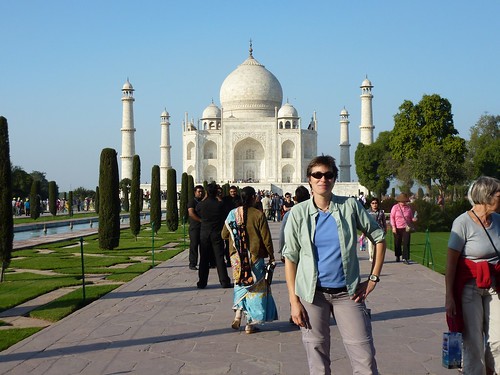 Mandatory shot of me at the Taj Mahal, followed by mandatory bit of Taj history:
Mandatory shot of me at the Taj Mahal, followed by mandatory bit of Taj history:
The Taj Mahal was built by Shah Jahan as a mausoleum for his favourite wife, Mumtaz. They were married for 18 years before she died while giving birth to their 14th child. That’s why the Taj is sometimes called the ultimate monument to love. Construction started in 1621 and finished 21 years later in 1653, and more than 20,000 labourers worked on it. It cost about 41,000,000 Rupees at the time, about $10,000,000.
It really is beautiful, though it was (I know I must sound like a broken record when I say this) kind of was smaller than I expected. However the details and intricacy of the decoration inside is amazing. The tomb itself is surrounded by an octagonal stone screen, carved similarly to the one above, but in much thinner stone (white marble, of course) and with an smaller, finer design. And around the edges were more floral patterns of inlaid semiprecious stones like in the fort. But again these were infinitely more delicate – I overheard one guide say that each lotus blossom pictured had 64 individual pieces of stone in it, and they were only about two and a half inches across.
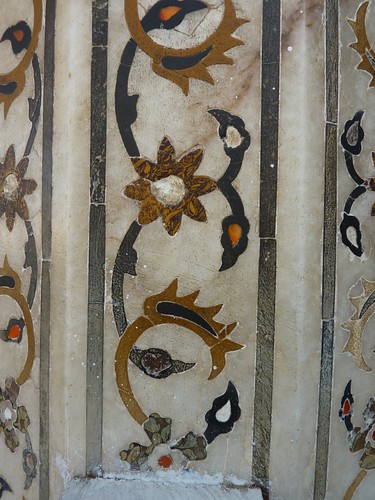 No photos are allowed inside the mausoleum, this is an example of the type of inlay work I’m talking about (from the fort) but on a cruder level.
No photos are allowed inside the mausoleum, this is an example of the type of inlay work I’m talking about (from the fort) but on a cruder level.
We looked around inside some more, then went out to wait on an empty bench for sunset to arrive, so we could get our all-important photos. There were lots of people everywhere, but I was surprised that a couple of prime photo spots were open, and came equipped with helpful Indians who would show you exactly where to crouch down to get a nice picture of the Taj reflected in the pools out front. Patti and I each took too many pictures, and then finally decided that we were finished with the Taj Mahal and headed out of the complex and back to the hotel.
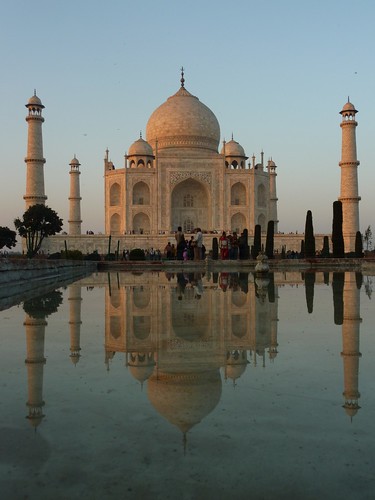 My best “money shot” of the Taj. Many many others are over at Flickr.
My best “money shot” of the Taj. Many many others are over at Flickr.
True to form, we took the wrong exit and then a wrong turned wrong and got hopelessly lost. This was ok though, because it meant we got to take a motor rickshaw, which are those three-wheeled contraptions you see everywhere. It cost quite a bit – 100 Rupees ($5.00!), but it included a tour of what seemed like the whole city of Agra, with frequent virtuoso solos on rickshaw horn.
After another short break we gathered in the lobby to go for dinner, but Akshay first asked us if we were interested in visiting a carpet factory, for a tour of the facility and a little lesson on how hand-knotted carpets are made. I was wary because my experience with these kind of things is that they inevitably end in a showroom with a sales pitch. However, Akshay assured us there would be no pressure to buy, so we gave it a go. And you know what? Despite the fact that I’d just seen the Taj Mahal, I think I actually had more fun at the carpet factory, and I learned a lot.
We started with a brief stop at a hand loom where a man was knotting a carpet, then we moved on to see how the carpets are washed by hand. A four foot by six foot carpet takes one man five hours to complete for each washing, and there are many washings involved. Then we saw the big piles of wool waiting to be used and also went upstairs and saw the design room where the carpet designs are rendered into graph paper so that the patterns can be recreated by the village women who are employed by the company – they’re usually illiterate rural women with no other means of support.
The company itself is one that’s supported by the government as a mean of promoting clean, socially responsible industry in the area. Apparently there’s a lot of industry in the area that creates pollution which, in turn, discolours the marble on the Taj Mahal (Nevermind that it also discolours the lungs of the residents, clearly this is a governement that know which side its bread is buttered on.) The government provided the money to buy the looms, and the company has distributed these looms to woman in rural areas, and taught them how to use them. They train women because, as the company representative explained, women have more patience for the fine and tedious work involved. More importantly, when money flows into the family through the woman, it actually flows into the family, as opposed to ending up at the local bar, when it’s earned by the man.
After viewing the design room we saw how the carpets are trimmed after they’re knotted. Of course that’s also done by hand, in three stages. An expert trimmer uses a plain pair of scissors and simply trims the excess length from the hand-knotted strands. This would be like using a pair of scissors to cut a four foot by six foot patch of lawn, and having EVERY BLADE come out exactly the same length. It was astonishing. And there’s the six months it took two people working full time to knot the carpet in the first place, or the fifteen hours for cleaning it three times, or the inspection for quality control, or any number of the other critical steps in the process. I used to think handmade carpets were ridiculously expensive, but now that I’ve seen how much labour goes into them, I can’t believe how reasonable the prices are.
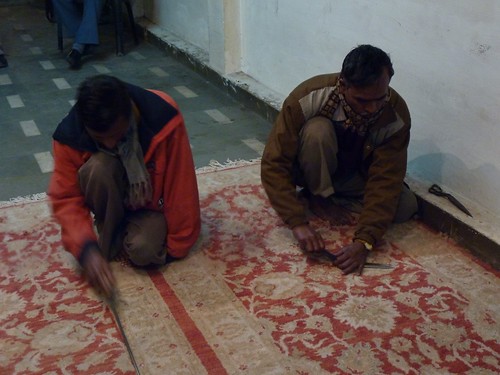 A trimmer at work on the right. The guy on the left is using a long pointed metal tool and rubbing it through all the strands of the carpet to make sure every one stands up straight.
A trimmer at work on the right. The guy on the left is using a long pointed metal tool and rubbing it through all the strands of the carpet to make sure every one stands up straight.
And yes, there was a visit to the showroom and complimentary cups of chai, and the unrolling of many carpets. And there were actually three sales, though none of them were to me. I was sorely tempted, but then I realized that I was just getting caught up in the fun of it all, and I really don’t need a carpet, especially since I don’t actually have a floor. Also, I’m buying an iPhone (I think), so I’ll just have to look at my pictures of carpets on my iPhone, and be content with that.

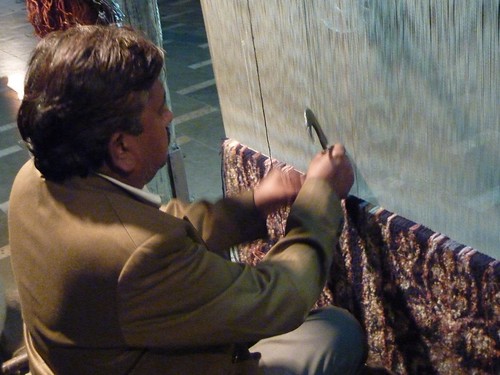


2 Comments:
Nice pics - go see the rest on Flickr.
The hair is looking good too.
Happy Trails...
OMG that new camera is to DIE for! Major kudos to the photographer - great eye!
Post a Comment